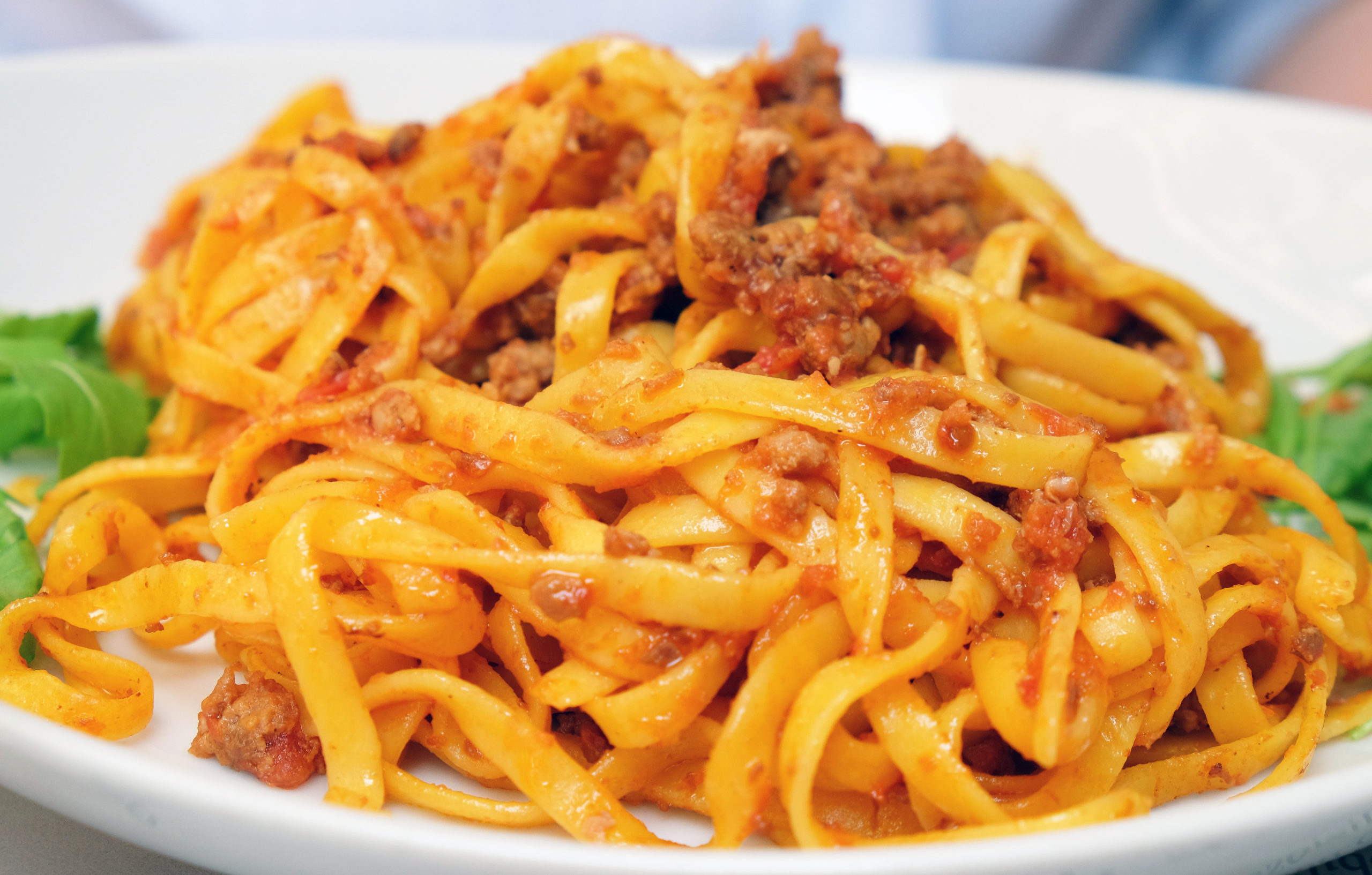Bolognese sauce: history, curiosity and original recipe
It is one of the most famous Italian recipes in the world and boasts countless attempts at imitation, but what is the true origin of Bolognese ragù?
Born as a meat dish in Renaissance France, the sauce recipe has traveled to the Bourbon Neapolitan court and then spread throughout the peninsula. It was the time when royalty marked trends in fashion, customs and even gastronomic art.
Botticelli – Banchetto nel Bosco, Ph. Museo Prado Madrid
Today the Bolognese sauce is one of the most famous recipes in the world, spreading abroad along the routes of Italian emigrants who brought with them the flavors of their homeland. La sua diffusione ha poi portato a innumerevoli declinazioni internazionali, come gli spaghetti bolognese, American transposition of the original recipe prepared with ingredients and according to local taste (often mixing intuitions of different parts of Italy).
The history
But where did the sauce come from and where did its two most famous versions, the Neapolitan and the Bolognese?
It is common to trace the origin of the term ragout to the French equivalent ragout, term with which once they were called stews of meat and vegetables cooked over low heat for a long time. The ancient ancestor of what we now call ragout was in fact a preparation of the medieval French folk tradition of the twelfth-fourteenth century, which consisted in stewing over low heat and broth pieces of meat, vegetables and even fish. Depending on the cuts of meat, spices and toppings that were used it could become both a rich and poor dish. Obviously, it did not involve the use of tomato.
From France to Italy, this preparation spreads through the kitchens of the Bourbon court and the cardinals of the Vatican, but it is still a method of cooking meat susceptible to variations.
In his "The gallant cook"of 1773, Vincenzo Corrado describes for the first time a kind of first ragout, but the ingredients are not yet defined (veal, sweetbreads, shrimp or eggs) and cooking is still done in broth with vegetables and aromatic herbs. You can use it to flavor other dishes or as a filling, but still there is no trace of pasta or tomato.
Now the recipe has become part of Italian gastronomy, and so it spreads throughout the country, finding changes and new ingredients such as the use of tomato, which appears for the first time in the "Maccheroni alla Napolitana" inside "L'Apicio moderno", 1790 cookbook by Francesco Leonardi. Although famous, ragù is still considered a meat dish in sauce, and that’s how Puccini remembers it in his Bohème.
In the following years will alternate versions of the same dish, with or without the addition of tomato. Only during the twentieth century with the spread of tomato and pasta this recipe will take the contours of the sauce that we still appreciate today. Throughout the 1800s, ragout spread throughout the peninsula with the introduction of local variations, such as the use of pork (initially not contemplated), the preparation of small meatballs (as in the Neapolitan and Abruzzo tradition) and matching with local pasta types, such as pasta in Emilia.
Ragù bolognese
When in 1891 Pellegrino Artusi in "The science in cooking and the art of eating well"describes the Maccheroni alla bolognese, he still does not know that he is laying the foundations for one of the most famous culinary myths of Italian cuisine.
The tomato is not yet contemplated, but the other ingredients are almost all: salted pork bacon, veal flavored with celery, carrot and onion, all cooked with meat broth.
Artusi also suggests some additions to enrich this seasoning: dried mushrooms, truffles, chicken livers and cream that, together with milk, will enjoy alternate fortunes inside the meat sauce to the present day. A white ragù in which the tomato is not yet placed, but rich and tasty, as the Bolognese tradition wanted.
The definitive transformation takes place at the end of the first decade of the twentieth century, when almost all the gastronomic authors chose to replace tagliatelle instead of macaroni (variant already suggested by Artusi) and for the constant insertion of tomato.
To complete the ingredients of the meat sauce will finally arrive fresh pork, but only after World War II, as reported by the famous Cucchiaio d'Argento, which proposes a recipe remained substantially unchanged to this day. Recipe, although it would be better to say recipes, which however does not correspond in all respects to the crystallization of the sauce, deposited in 1982 at the Chamber of Commerce of Bologna by the Delegation of Bologna Accademia Italiana della Cucina (which we report below).
Perhaps this is also the beauty of Italian cuisine, so familiar, widespread and open that can vary from house to house.
Ragù bolognese - the recepie filed
The recipe of the classic Bolognese ragù was deposited at the Chamber of Commerce of Bologna, October 17, 1982 by the Delegation of BolognaAccademia Italiana della Cucina.
Ingredients:
300 g of beef pulp (briefcase or belly or shoulder or fusello) coarsely ground, 150 g of pork bacon, 50 g of yellow carrot, 50 g of celery, 30 g of onion, 300 g of tomato sauce or peeled, ½ glass of dry white wine, ½ glass of whole milk, little broth, extra virgin olive oil or butter, salt, pepper, ½ glass of whipped cream (optional).
Preparation:
Melt, in a pan of possibly terracotta or thick aluminum, about 20 cm, the bacon cut first into cubes and then finely chopped with the crescent. Add 3 tablespoons of oil or 50 g of butter and the finely chopped odors and gently wilt. Add the minced meat and mix well with a ladle and sauté until "sizzle". Wet with the wine and mix gently until it is completely evaporated. Add the pureed or peeled tomatoes, cover and simmer slowly for about 2 hours, adding, when necessary, some broth, and towards the end add the milk to dampen the acidity of the tomato. Season with salt and pepper. At the end, when the sauce is ready, according to the Bolognese use, add the cream if it is to season dry pasta. For the tagliatelle its use is to be excluded.
This is the updated recipe
Tools needed:
Terracotta pan about 20 cm in diameter
Wooden spoon
Crescent-shaped knife
Procedure:
Melt in the pan the bacon cut into cubes and chopped with the crescent; add the vegetables well chopped with the crescent and let them gently wither; add the minced meat and leave it, stirring until it sizzles; Put 1 2 glass of wine and tomato elongated with a little broth; let simmer for about two hours adding, time by time, the milk and adding salt and black pepper. Optional, but advisable, the addition, when cooked, of the cooking cream of one liter of whole milk.
Did you know the recipe? Have you ever tried to taste it cooked by a local? Among many proposals, we have a tour that will allow you to enter the homes of local families, learn how to cook pasta and eat it all together amidst chatter and laughter!



